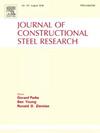考虑构件屈曲的螺栓球面连接破坏机理研究
IF 4
2区 工程技术
Q1 CONSTRUCTION & BUILDING TECHNOLOGY
引用次数: 0
摘要
螺栓球面连接是空间桁架结构中常用的一种连接方式。对2013年芦山地震中关节断裂的调查有了显著的发现。值得注意的是,连接断裂螺栓的构件显示出屈曲的迹象,这表明拉力不是导致螺栓断裂的原因。这种破坏模式明显偏离了基于设计原则的预期,需要对其断裂机制进行彻底的检查。对9种不同螺栓连接的球形钢管复合材料构件进行了全尺寸试验,重点研究了其在地震条件下的性能。随着构件屈曲的加剧,螺栓的角度增加,使其承受弯矩。裂缝逐渐出现,直至破裂;它代表了一种新的螺栓球形连接螺栓失效模式。此外,试验结果表明,随着螺栓厚度的增加,复合材料构件的下延性降低。对螺栓球节点对复合材料构件屈曲能力的影响进行了参数化分析,提出了考虑构件屈曲效应的螺栓球节点破坏公式。理论模型解释了螺栓直径越大对应的破坏角越小,螺栓越容易断裂。本文提出的相关理论可以增强实际工程项目的设计基础。本文章由计算机程序翻译,如有差异,请以英文原文为准。
Study on failure mechanism of bolted spherical joints considering buckling of members
Bolted spherical joints are frequently utilized in spatial truss structures. An investigation into joint fractures during the 2013 Lushan earthquake revealed notable findings. Remarkably, the member connected to the fractured bolt exhibited signs of buckling, suggesting that tension forces did not cause the bolt failure. This failure mode significantly deviates from expectations based on design principles and warrants a thorough examination of its fracture mechanism. Full-scale experiments were conducted on nine distinct bolted spherical steel tube composite members, focusing on their performance under earthquake conditions. As the member's buckling intensified, the bolt's angle increased, subjecting it to a bending moment. Cracks gradually appear until they break; it represents a newly identified failure mode of bolts in the bolted spherical joints. Furthermore, the test result indicated that as bolt thickness increased, lower ductility in the composite component decreased. A parametric analysis of the influence of bolt ball joint points on the buckling capacity of composite members was conducted, proposing a failure formula for the bolts in these joints that account for the member's buckling effect. The theoretical model explains that the larger the bolt diameter corresponds, the smaller the failure angles, making it easier for bolts to fracture. The relevant theories presented in this paper could enhance the design foundation for practical engineering projects.
求助全文
通过发布文献求助,成功后即可免费获取论文全文。
去求助
来源期刊

Journal of Constructional Steel Research
工程技术-工程:土木
CiteScore
7.90
自引率
19.50%
发文量
550
审稿时长
46 days
期刊介绍:
The Journal of Constructional Steel Research provides an international forum for the presentation and discussion of the latest developments in structural steel research and their applications. It is aimed not only at researchers but also at those likely to be most affected by research results, i.e. designers and fabricators. Original papers of a high standard dealing with all aspects of steel research including theoretical and experimental research on elements, assemblages, connection and material properties are considered for publication.
 求助内容:
求助内容: 应助结果提醒方式:
应助结果提醒方式:


